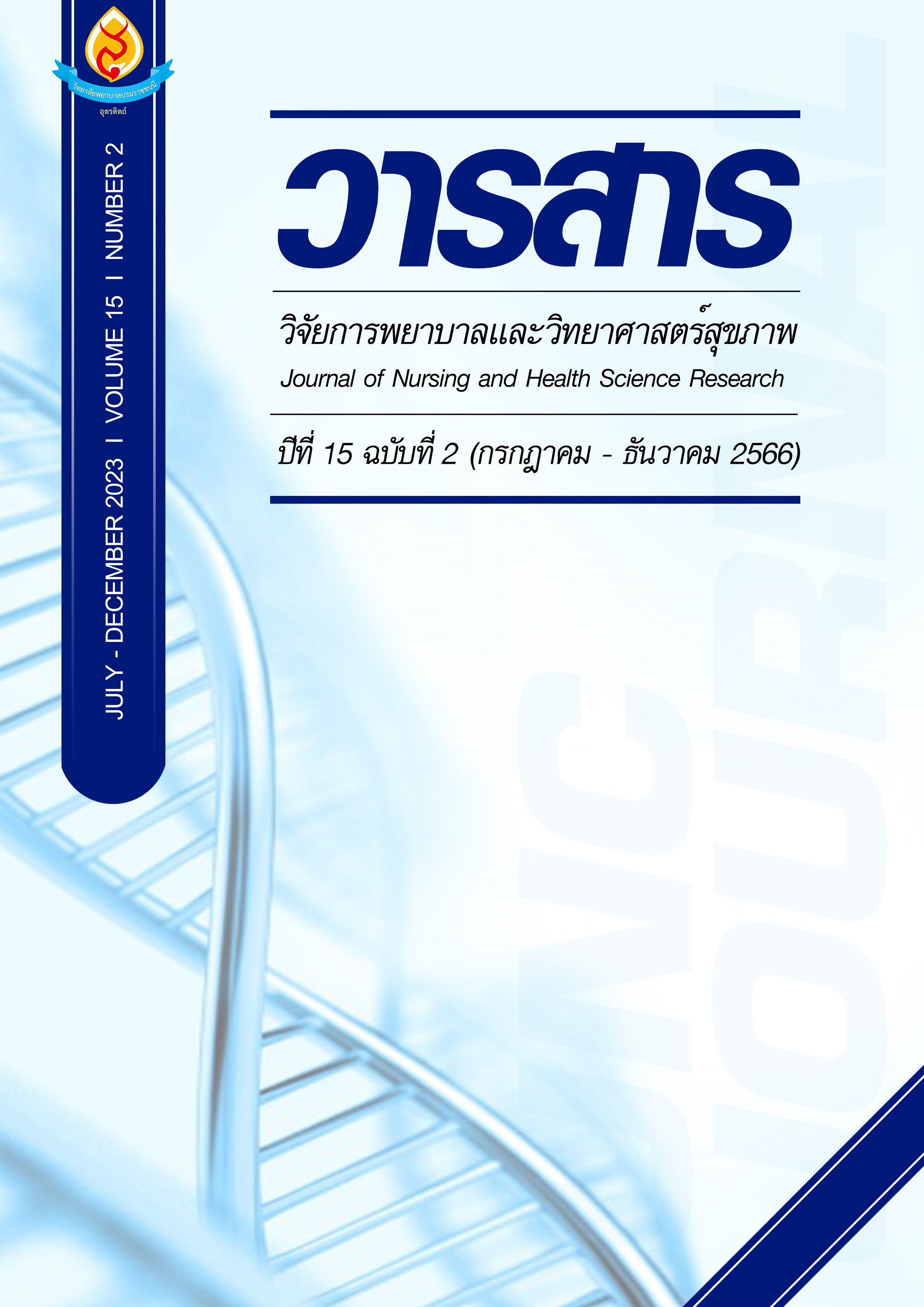ความรู้และความรอบรู้ด้านสุขภาพต่อทักษะการสื่อสารสุขภาพเกี่ยวกับโรคโควิด-19 ของนักศึกษาพยาบาลศาสตร์ ในวิทยาลัยพยาบาลบรมราชชนนี สถาบันพระบรมราชชนก เขตสุขภาพที่ 1
Main Article Content
บทคัดย่อ
การวิจัยนี้มีวัตถุประสงค์เพื่อศึกษา 1) ระดับความรู้ ความรอบรู้ด้านสุขภาพ และทักษะการสื่อสารสุขภาพ และ 2) เปรียบเทียบทักษะการสื่อสารสุขภาพเกี่ยวกับโรคโควิด-19 ของนักศึกษาพยาบาลศาสตร์ ชั้นปีที่ 1 - 4 และระดับความรู้ ระดับความรอบรู้ทางสุขภาพเกี่ยวกับโรคโควิด-19 ใช้รูปแบบการวิจัยเชิงพรรณนา กลุ่มตัวอย่างเป็นนักศึกษาพยาบาลศาสตร์ ภาคเรียนที่ 1 ปีการศึกษา 2565 วิทยาลัยพยาบาลบรมราชชนนี ในเขตสุขภาพที่ 1 จำนวน 4 วิทยาลัย ได้มาโดยการสุ่มแบบอัตราส่วน จำนวน 719 คน เครื่องมือที่ใช้ในการวิจัย ประกอบด้วยแบบวัดความรู้เรื่องโรคโควิด-19 เป็นแบบถูกผิด แบบวัดความรอบรู้ด้านสุขภาพ และแบบวัดทักษะการสื่อสารสุขภาพเกี่ยวกับโรคโควิด-19 เป็นแบบมาตราส่วนประมาณค่า 5 ระดับ มีค่าความเชื่อมั่นเท่ากับ .87, .91, และ .89, ตามลำดับ สถิติเชิงพรรณนาใช้ค่าความถี่ ร้อยละ ค่าเฉลี่ยและส่วนเบี่ยงเบนมาตรฐาน สถิติอ้างอิงใช้การวิเคราะห์ความแปรปรวนแบบทางเดียว (One way ANOVA)
ผลการวิจัยสรุปได้ดังนี้
1. ระดับความรู้และทักษะการสื่อสารสุขภาพเกี่ยวกับโรคโควิด-19 ของนักศึกษาอยู่ในระดับปานกลาง
2. ความรอบรู้ด้านสุขภาพเกี่ยวกับโรคโควิด-19 ของนักศึกษาชั้นปีที่ 1 - 4 อยู่ในระดับมาก
3. นักศึกษาชั้นปีต่างกันมีทักษะการสื่อสารสุขภาพเกี่ยวกับโรคโควิด-19 แตกต่างกันอย่างมีนัยสำคัญทางสถิติที่ระดับ .05
4. นักศึกษาที่มีความรู้เรื่องโควิด-19 ต่างกันมีทักษะการสื่อสารสุขภาพเกี่ยวกับโรคโควิด-19 แตกต่างกันอย่างมีนัยสำคัญทางสถิติที่ระดับ .05
5. นักศึกษาที่มีระดับความรอบรู้ด้านสุขภาพเกี่ยวกับโรคโควิด-19 ต่างกันมีทักษะการสื่อสารสุขภาพเกี่ยวกับโรคโควิด-19 แตกต่างกันอย่างมีนัยสำคัญทางสถิติที่ระดับ .05
Article Details

อนุญาตภายใต้เงื่อนไข Creative Commons Attribution-NonCommercial-NoDerivatives 4.0 International License.
บทความหรือข้อคิดเห็นใดใดที่ปรากฏในวารสารวิจัยการพยาบาลและวิทยาศาสตร์สุขภาพ เป็นวรรณกรรมของผู้เขียน ซึ่งบรรณาธิการหรือสมาคมศิษย์เก่า ไม่จำเป็นต้องเห็นด้วย และบทความที่ได้รับการตีพิมพ์เผยแพร่ถือเป็นลิขสิทธิ์ของวารสารวิจัยการพยาบาลและวิทยาศาสตร์สุขภาพ
เอกสารอ้างอิง
Bureau of Risk Communication and Health Behavior Development & Intrakhamhang, A. (2018). Report of health literacy on disease control under the District operational model development project for health literacy and preventive behavior. Nontaburi: Department of Disease Control, Ministry of Public Health.
Chaipan, N. & et al. (2021). A manual on the process of building health literacy in prevention and control disease and health threats. Bangkok: R.N.P.P.Water. (in Thai).
Chanmuean, Y. (2022). Health communication of the public health ministry: the case study of the coronavirus disease 2019 (COVID-19) Pandemic. Journal of Health Science, 31(1), 62-73. (in Thai).
Chamnian, M. & Kaewsanit, M. (2018). Health communication to promote the well-being for the community people. Association of Private Higher Education Institutions of Thailand, 24(4), 155-66. (in Thai).
Chansawang, W. (2007).Communication process: strategies in health education and health promotion. Bangkok: Chareondeemunkong printing. (in Thai).
Cochran, WG. (1977). Sampling techniques. 3rd edition. New York: John Wiley & Son.
Cockerham, G. B. (2010). Institutional design of ASEAN and regional integration. East Asia, 27, 165-185.
Department of Disease Control. (2018).Crisis risk communication manual: crisis risk communication. Bangkok: Kaewchaochom Media and Publishing Center Suan Sunandha Rajabhat University. (in Thai).
Department of Disease Control. (2021). COVID-19 situation report for wave 1 to wave 2 from 12 March 2020 to 31 March 2021.The situation of infected people with COVID-19 is updated weekly in API API (JSON/CSV Data Format). Retrieved from https://covid19.ddc.moph.go.th/. (in Thai).
Department of Disease Control. (2021).COVID-19 situation report for wave3 from 1 April 2021 to 31December 2021. The situation of infected people with COVID-19 is updated weekly in API (JSON/CSV Data Format). Retrieved from
https://covid19.ddc.moph.go.th/. (in Thai).
Department of Disease Control. (2022). COVID-19 situation report for wave 4 from 1 January 2022 to Current. The situation of infected people with COVID-19 is updated weekly in API (JSON/CSV Data Format). Retrieved from
https://covid19.ddc.moph.go.th/. (in Thai).
Faculty of Nursing, Praboromarajchanok Institute. (2022). A guide for students of the Bachelor of Nursing Science Program, Academic Year 2022. Nonthaburi: Faculty of Nursing, Praboromarajchanok Institute. (in Thai).
Fongkerd, S. et al. (2021). Health literacy and self-care behavior among type 2 diabetic patients. Journal of Health Sciences Scholarship, 8(1), 207-222. (in Thai).
Health Learning Center. (2022).Study report: synthesis of learning process data that creates health literacy. Bangkok : Thai Health Promotion Foundation. (in Thai).
Health Region1. (2019). Retreat health region1, Fiscal year 2019. Chiang Mai: Office of Health Region1. (in Thai).
Jaikham, J., Wungrath, J. & Thongprachum, A. (2021). Health literacy and health promoting behaviors regarding to 3E.2S. among village health volunteers in Ban Hong district, Lamphun province. Journal of Health Sciences Scholarship, 8(2), 1-24. (in Thai).
Kaeodumkoeng, K. (2018). Health literacy : access, understanding, and application. 2nd ed. Bangkok: Amarin Printing and Publishing Public. (in Thai).
Kaeodumkoeng, K. (2019). Health literacy: functional, interactive, critical. Bangkok: Amarin Printing and Publishing. (in Thai).
Kaeodumkoeng, K. (2021). Health literacy: Processes, Practices, Evaluation tools. Bangkok: ID All Digital Print. (in Thai).
Lattanand, K. & Ninwatcharamanee, C. (2019). Health literacy of nursing students at Boromarajonani College of Nursing Bangkok. Journal of Boromarajonani College of Nursing, Bangkok, 35(1), 277-289. (in Thai).
Nutbeam, D. (2000). Health literacy as a public health goal: a challenge for contemporary health education and communication strategies into the 21st century. Health Promotion International, 15(3), 259-267.
Nutbeam, D. (2008). The evolving concept of health literacy. Social Science & Medicine, 67(12), 2072-2078.
Obidiegwu, U.J. & Ajibare, J.O.O. (2007). Blooms mastery Learning Theory: Implications on Adult Education. Retrieved from http://woeks.bepress.com/druche.
Pancharoen, C. & Ngamphaiboon, C. (in Editor). (2014). Communication Skills Handbook for Nurses. and nursing students. 2nd . Bangkok: Active Print. (in Thai) .
Pancharoen, C. (2017). Communication skills: professional medical communication. Bangkok : Active Print. (in Thai).
Prachusinlapa, S. & et al. (2008). Dissemination of health information through the internet to the public health communication. 2nd. Bangkok: Phabpim. (in Thai).
Research and development plan for health communication system to the people, Public Health Systems Research Institute. (2008) . Health Communication. 2nd . Bangkok: Phabpim. (in Thai).
Somphopjareon, M. (2022). Health communication for health literacy. 3rd ed. Bangkok: Jareondeemunkong. (in Thai).
Srichai, M. (1996). Sampling techniques. 2nd ed. Bangkok: VJ. Printing. (in Thai).
Sukcharoen, P. (2018).The development of communication skills for nursing students. Chonburi Hospital Journal, 43(3), 237-242. (in Thai).
Sukrueangkul, A. et al. (2022). Factors associated with health literacy among nursing students in faculty of nursing, college of asian scholars, Khon Kaen province. Regional Health Promotion Center 9 Journal, 16(1), 156-171. (in Thai).
Thitichai, P. & Thaweevikayagarn, P. (2021). Report of review COVID-19 situation and preventive to control and prevent at the world level and in Thailand. Nontaburi: Division of Non-Communicable Disease, Department of Disease Control, Ministry of Public Health.
Walpole, R, E. (1974). Introduction to statistics. New York: Macmillan.
Wauters, Y. & Promtong, K. (2021). Communication skills to promote health literacy as percived by nursing students in the southern nursing college network. The Southern College Network Journal of Nursing and Public Health, 8(2), 13- 25. (in Thai).
Wisitcharoen, K. et al. (2021). Correlational between personal factors and health literacy on health status among buddhist monk at Ongkharak district, Nakhorn Nayok province. Boromarajonani College of Nursing, Uttaradit Journal, 13(1), 266-282. (in Thai).
Yamane ,T. (1973). Statistics: an introductory analysis. 3rd ed. New York: Harper and Row Publications.


